#human evolutionary anatomy
Text
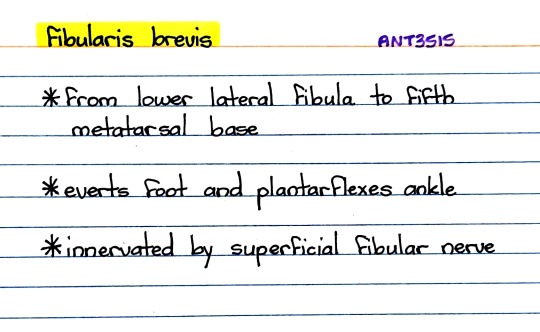
Patreon
#studyblr#notes#medblr#medical notes#med notes#anatomy#human anatomy#evolutionary anatomy#human evolutionary anatomy#evolution#evolutionary biology#biology#bio#anatomy notes#human evolution#evolutionary bio#evo bio#evodevo#evolutionary development#developmental biology#devbio#anthropology#anthropology notes#bioanthropology#biological anthropology#anatomy and physiology#anatomy & physiology#medical science#life science#health science
6 notes
·
View notes
Text
Apes are a kind of monkey, and that's ok
This is a pet peeve of mine in sci comm ESPECIALLY because many well respected scientific institutions are insistent about apes and monkeys being separate things, despite how it's been established for nearly a century that apes are just a specific kind of monkey.
Nearly every zoo I've visited that houses apes has a sign somewhere like the one below that explains the supposed distinction between the two groups, focusing on anatomy instead of phylogeny.

(Every time I see a graphic like this I age ten years)
Movies even do this, especially when they want to sound credible. Take this scene from Rise of the Planet of the Apes:
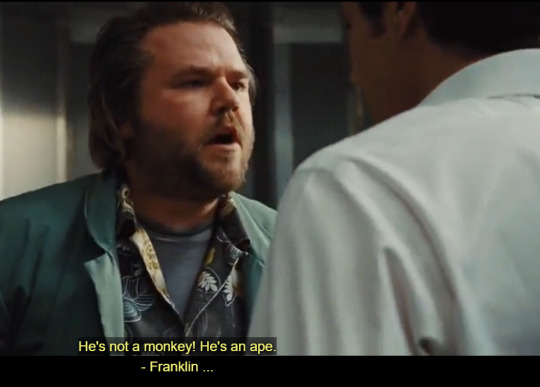
This guy Franklin is presented as the authority on apes in this scene, and he treats James Franco calling a chimpanzee a monkey like it's insulting.
But when you actually look at a primate family tree, you can see that apes are on the same branch as Old World monkeys, while New World monkeys branched off much earlier.

(I'm assuming bushbabies are included as "lorises" here?)
To put it simply, that means you and I are more closely related to a baboon than a baboon is to a capuchin.
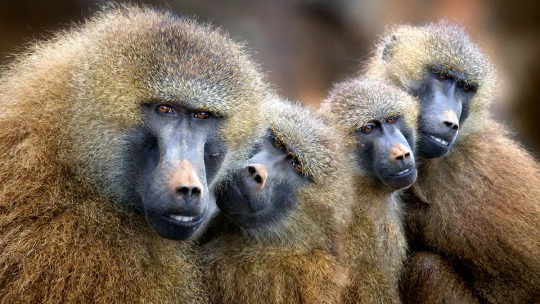
Either the definition of monkey includes apes OR we can keep using an anatomical definition and Barbary macaques get to be an ape because they're tailless.

"I've got no tails on me!"
SO
Why did all this happen? Why did we start insisting apes are monkeys, especially considering the two words were pretty much interchangeable for centuries? Well I've got one word for ya...

This the attitude that puts humans on a pedestal over other life on Earth. That there are intrinsically important features of humanity, and other living things are simply stepping stones in that direction.
At the dawn of evolutionary study, anthropocentrism was enforced by using a model called evolutionary grades. And boy howdy do I hate evolutionary grades.
Basically, a grade is a way of defining a group of animals by using anatomical "complexity". It's the idea that evolution has milestones of importance that, once reached, makes an organism into a new kind of thing. You can almost think of it like evolutionary levels. An animal "levels up" once it gains a certain trait deemed "complex".
You can probably see the issue here; that complexity is an ephemeral idea defined through subjectivity, rather than based off anything truly observable. What makes walking on 2 legs more complex than walking on four? How are tails less complex than no tails? "Complexity" in this context is unmeasurable, therefore it is unscientific. That's why evolutionary grades suck and I never want to look at one.
For primates, this meant once some of them lost their tails, grew bigger brains, and started brachiating instead of leaping, they simply "leveled up" and became apes. Despite the early recognition that apes were simply a branch of the Old World monkey family tree (1785!), the idea of grades took precedent over the phylogenetic link.
In the early years of primatology, humans were even seen as a grade "above" apes, related but separated by our upright stance and supposed far greater intelligence (this was before other apes were recognized tool users).

It wasn't until the goddamn 1970s that it was recognized all great apes should be included in the clade Hominidae alongside humanity. This was a major shift in thinking, and required not just science, but the public, to recognize just how close we are to other living species. It seems like this change has, thankfully, happened and most institutions and science respecting folks have accepted this fact. Those who don't accept it tend to have a lot more issues with science than only accepting humans as apes.

And now, we come to the current problem. Why is there a persistent idea that monkeys and apes are separate?
I want to make it clear I don't believe there was a conscious movement at play here. I think there's a lot of things going on, but there isn't some anti-monkey lobby that is hiding the truth. I think the problem is more complicated and deals with how human brains and human culture often struggle to do too many changes at once.
Now, I haven't seen any studies on this topic, so everything I say going forward is based on my own experience of how people react to learning apes (and therefore, humans) are monkeys.
First off, there is a lot of mental rearranging you have to do to accept humans as monkeys. First you, gotta accept humans as apes, then you have to stop thinking in grades and look at the family tree. Then you have to accept that apes are on the Old World monkey branch, separate from the New World monkeys.
That's a lot of steps, and I've seen science-minded zoo educators struggle with that much mental rearranging. And even while they accept this to an extent, they often find it even harder to communicate these ideas to the public.
I think this is a big reason why zoos and museums often push this idea the hardest. Convincing the public humans are apes is already a challenge, teaching them that all apes are monkeys at the same time might seem impossible.
I believe the other big reason people cling to the "apes-aren't-monkeys" idea is that it still allows for that extra bit of comforting anthropocentrism. Think of it this way; anthropocentrism puts humans on a pedestal. When you learn that humans are apes, you can either remove the pedestal and place humans with other animals, OR, you can place the apes up on the pedestal with humanity. For those that have an anthropocentric worldview, it can actually be easier to "uplift" the apes than ditch the pedestal.
Too make things worse, monkeys are such a symbol of a "primitive" animal nature that many can't accept raising them to the "level" of humanity, but removing the pedestal altogether is equally painful. So they hold tight to an outdated idea despite all the evidence. This is why there's often offense taken when an ape is called a monkey. It's tantamount to someone calling you a monkey, and that's too much of a challenge to anthropocentrism.
Personally, I think recognizing myself as a monkey is wonderful. Non-ape monkeys are as "complex" as any ape. They make tools, they have dynamic social groups, they're adapted to a wide range of environments, AND they have the best hair of all primates.
I think we should be honored to be considered one of them.



3K notes
·
View notes
Text
June walked into the main room to find Ratchet staring at various humam anatomy diagrams displayed through the monitors.
Bones, muscles, nerves, etc.
All of them focused sorely on the arms, wrists, and hands.
"Doing some human research, Ratchet?"
The autobot hums in affirmation.
"I believe Rafael's arms to be damaged. I'm researching possible treatment."
"What!? Raf is hurt?! What happened? Where is he?"
"Relax, he's not injured, just damaged. I suspect it is either an old injury acting up or poorly maintenance."
"He shouldn't have any old injury like that, I believe. Is he in pain?"
"No to my knowledge. But I've seen him manually recalibrate his servos way too often for it to be healthy."
June blinks, confused.
"Recalibrate his servos?"
Ratchet scoffs. "You know, when he," Ratchet holds his hands in front of his body, and after a slight pause, he flaps them in a quick (and loud) motion "does this. If Rafael was a bot, the only reason to do that would be to loosen up rusted joints and recalibrate his motors. It's not a particularly bad habit, but Rafael does it multiple times a day. His joints, human or not, should NOT de-align so fast. Something is clearly wrong, so -"
"Ratchet." June interrupted, sounding relieved.
"Raf's arms aren't damaged. He's just stimming."
Ratchet resets his optics, baffled. "What's stimming?"
Later that night, Ratchet finds himself working side to side with Optimus on the main console.
"I learned something new about humans today."
"Oh?" Optimus intoned, optics still focusing on his work, but voicing his curiosity.
"You know that thing Bee does, where his doorwings will flap in place when he comes back from a mission to find Rafael in the base? Or how Smokescreen's wheels start spinning when Ultra Magnus makes him stay in place too long for a lecture?"
The way your headlights would start blinking in sync with your voice, as you excitedly explained to me a new document you found in the archives, before you trained yourself out of it, because it was unsightful of a Prime.
"Turns out humans have a word for it. They call it stimming."
Optimus eyes brighten with interest. And as he starts babling theories about possible evolutionary needs for this stimming (a release of excess energy caused by low activity? or perhaps a smaller body than usual, or maybe it had nothing to do with energy and was instead a way to signal other nearby humans about their emotional state?) Ratchet couldn't help but steal a glance towards the Prime's headlights.
He couldn't help but feel disappointed to see them completely dark all through his tirade.
---
@quetzalpapalotl dunno if you recall but i made a lil post talking about this, that you liked, and i turned it into this lil thing!
(Btw, i hope its okay to keep @ u when i write this lil things that i think youd like? I dont wanna come off as spammy kydkgdkgd)
435 notes
·
View notes
Text
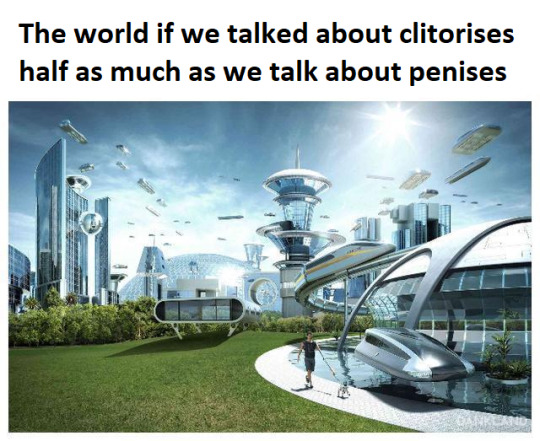
I’ll start!
1. the clitoris is present in ALL mammal species, as well as many species of birds and reptiles.
2. the clitoris is mostly internal, much larger than you think, and capable of erection. It is made of the exact same tissue types as the penis. It extends from the head of the clitoris (external) all the way to the sides of the vaginal opening (internal), sometimes beyond. it also extends laterally.
3. the full, accurate anatomy of the clitoris is missing from most medical texts. Doctors who perform pelvic surgeries may not know where your clitoral nerves are, and may sever them.
4. most women cannot orgasm without clitoral stimulation, and yet many men expect them to. I suggest these men orgasm without penile stimulation.
5. Indian flying foxes have been observed engaging in cunnilingus, which increases the duration of penetrative sex. Non-human primates have also been observed engaging in cunnilingus.
6. Clitoral stimulation causes ovulation in some mammals for whom the clitoris lies inside the vaginal canal, suggesting an evolutionary function for the clitoris.
7. Some people like to hypothesize that the clitoris is vestigial, despite zero scientific evidence to back this up.
8. The scientific study of the clitoris has been severely impacted by misogyny. Misogyny is also evident in the lack of sex education on the clitoris, where it is often omitted or only discussed briefly.
9. The clitoris has over 10,000 nerve endings.
10. The clitoris is THE source of sexual pleasure and sexual function for 50% of our population.
1K notes
·
View notes
Note
suaropods on earth are the absolute upper limit for land vertebrates, but is it because they have four legs? cause i was working on a scifi spec evo idea where the endoskeletal vertebrate-analogs have eight legs and it got me wondering if it means their sauropod equivalents can be even bigger in a similar earth like gravity
If it was just about leg numbers then land mammals wouldn’t be smaller than the biggest dinosaurs
In reality you need specific evolutionary pressures, circumstances, and unique and efficient anatomy to get big.
For sauropods it was entirely due to their internal anatomy. Sauropods are saurischian dinosaurs, which have hollow bones with internal scaffolding that likely made them stronger than if they were solid, as well as a very extensive respiratory system that included numerous air sacks, many of which ran through their bones. This ultimately allowed saurischian dinosaurs to massively cut back on volume and allow them to cool off easier and have more efficient respiration. There’s things we still don’t know about sauropod anatomy though such as how their circulatory systems combated their sheer verticality. Dinosaurs also have unidirectional respiratory systems, which is more efficient than mammalian two way airflow.
For modern baleen whales it has more to do with the aftermath of the last ice age and how it impacted the location of their food (keep in mind this explanation of the evolution of baleen whale size is based on my current understanding and might not be correct). Baleen whales actually used to be much smaller, around bus size. But during and after the last ice age the ocean currents changed and krill populations became concentrated around the poles. Because of this, baleen whales needed a way to eat as much as possible in one sitting and travel long distances efficiently. The easy solution was to get big, which became easier as their predators the macroraptorial sperm whales and Otodus megalodon gradually went extinct. A thing to note however, is that because they need more resources due to their size, the number of baleen whale species is lower than it was several million years ago. Also also, blue whales are getting bigger.
On earth, 200 tons is more or less the maximum size for animals, as the biggest whales, ichthyosaurs, and sauropods got around that size.
There’s more things to note though:
No, higher oxygen levels don’t make things bigger. Not even bugs. Modern arthropods are actually on average bigger than their Carboniferous counterparts, and the oxygen levels were way higher back then. And griffinflies, very active flying insects, lasted all the way into the Permian, when oxygen levels were lower than in modern day.
It’s important to consider what the bones of animals are made of as well as their structure. Different internal structures can handle stress better, and different materials can handle pressure differently.
Eight legs might be too many, as having more legs, while very stable, can be more energy costly. Two legs might not be able to support as much weight as four, but it is more efficient.
A very big thing animals have to fight with when it comes to size is something called the square cube law. Basically as something gets bigger its volume (insides) increase way faster than its outsides (surface area). If you had a 1 centimeter cube and doubled its size, the surface area would quadruple but the insides would increase eight times. But there are ways of combating this such as decreasing volume with things like air sacks or increasing surface area by being very wrinkly (that’s how human brains fit so many neurons!). And because things with a metabolism generate heat, big animals have to combat overheating because they have a lot of insides. That’s why elephants have such big vascularized ears and why their skin acts like a sponge to soak up water.
Also I have no idea how perucetus got so big, that glorious fatass
#ask#questions#anon#anonymous#biology#paleontology#palaeoblr#speculative evolution#speculative biology#speculative anatomy#speculative zoology
188 notes
·
View notes
Text
#man did a megalosaurus and iguanadon fuck?#or is it like all the ones decended from either one are counted in the same group?#where did they evolve from?#is the term dinosaur like the term “fish” where its all weird?#but i do think dragons decended from the megalosaurus and the iguanadon#or at least certain kinds of dragons#perhaps without the mass extiction event that fuckin merked the dinos we couda got ourselves a dragon#but would there be humans?#i have so many questions
@moonboy-queerfingers moving to a new post but
It's not that Megalosaurus and Iguanodon fucked (they were millions of years apart)
It's that they were the first two dinosaurs discovered
SO we defined the group as *their family tree*, which means that the first dinosaur was the last ancestor they shared
so like, think about a family group of humans. you have distant cousins with your last name, because a few generations ago, your most recent common ancestor with said cousins had that last name.
"Dinosaur" is just that for species.
Fish is weird for many, many reasons, some are similar, but it's a whole other ball game. Essentially, all tetrapods (amphibians, reptiles+birds, mammals) evolved from fish, but weren't included in fish when we just classified things on traits. So, by evolutionary relationship, tetrapods are fish, but that's never what people mean when they say fish, so scientists don't know what to do. I personally vote we call tetrapods fish because a lot of our anatomy is directly because we are fish.
And we did actually have dragons among dinosaurs ! They're called Scansoriopterygids and they were small, but very much dragon like:
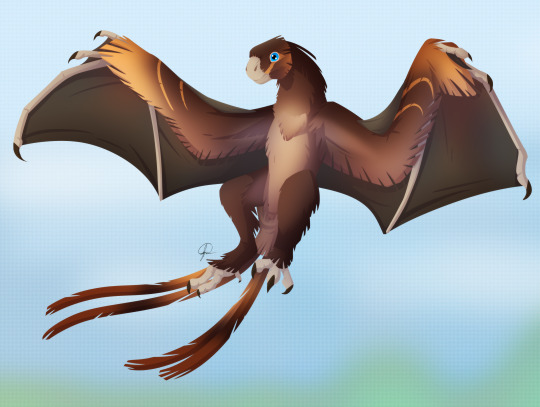
386 notes
·
View notes
Text
Let's delve into the intricacies of an Omegaverse society, drawing insights from both biology and evolution. As a social science student myself with a background in anthropology, I aim to explore various aspects of this complex world, including its prison system, bathroom arrangements, treatment of the transgender community, societal norms, stigmas, reproduction dynamics, birth rates, and even the portrayal of sexuality through pornography.
Collaborating with my best friend, a medical student well-versed in anatomy, we've pooled our knowledge to shed light on how such a society might function, drawing parallels and extrapolating from existing data in our world.

So. Within the Omegaverse, there exist two overarching categories, male and female, each subdivided into three distinct statuses: Alpha, Beta, and Omega. Over time, the majority of individuals have transitioned beyond the Alpha and Omega distinctions, akin to how the human female body evolved past its reproductive heat cycles during the paleolithic period, marking a pivotal moment in human evolution.
In the distant past, during the age, Alpha males and Alpha females coexisted alongside their counterparts, Omega males and Omega females. The differences between Alpha males and females were minimal, much like the similarities between the two Omega sexes. However, there still were differences in genitalia where only Alpha females and Omega males displayed intersex characteristics. The enlarged clitoris of an Alpha female, resembling but distinct from a penis, possessed a knot—a feature absent in Alpha males— because of it's inability to produce sperm which necessitated an evolutionary adaptation towards a larger knot, in order to increase the chances of pregnancy.

Like stated before, the transition into a largely Beta population occurred even before the neolithic era, resulting into a similar contemporary societal structure as we know today. However, there being secondary genders didn't stop the historical oppression of all women. Only now it extended to impact Omega males, though they can pass as Betas if their genitalia remains private. Contrary to popular beliefs, there is no discernible scent associated with Omegas in heat; instead, it is their aura and demeanor that undergo noticeable changes. A "sex appeal", if you will, that affects everyone except Beta women for a vast number of reasons i'll touch upon later.

Legal frameworks exists to address non-consensual interactions with Omegas in heat, and sometimes even with Alphas in ruts. Statistical data still reflects a disproportionate involvement of Alpha and Beta males in such crimes.
In cases of rape involving an Omega in heat, the perpetrator might exploit societal biases to justify their actions or even escape punishment altogether. They might argue that the Omega's biological state somehow diminished the severity of the crime.
Similarly, in cases of rape involving an Alpha in rut, the legal system might downplay the seriousness of the offense due to the perceived status and power of the victim over the perpetrator.
In such a society, power dynamics based on genetic status and gender could heavily influence the legal process as well. Despite the vulnerability of Omegas in heat and the potential vulnerability of Alphas in rut, the legal system might consider it an extenuating circumstance for the aggressor.
In the Alpha Beta Omega prison system, inmates are segregated based on their genetic status and gender to ensure safety and maintain social order. Alpha males and Alpha females, Beta males and Beta females & Omega males and Omega females are all housed in separate facilities due to the perceived risks associated with mixing different genetic statuses and genders.
This segregation is justified by concerns for safety, as it is believed that males, regardless of their secondary gender, have the potential to overpower females. By separating inmates in this manner, authorities aim to mitigate the risks of violence and maintain control within the prison environment.

Alphas and Omegas are not exceedingly rare, but they remain somewhat uncommon, often noted and remembered as peculiarities. Their presence evokes a similar level of curiosity as encountering a left-handed person or a natural redhead—an intriguing aspect of diversity that captures attention but is ultimately regarded with a level of casual interest.
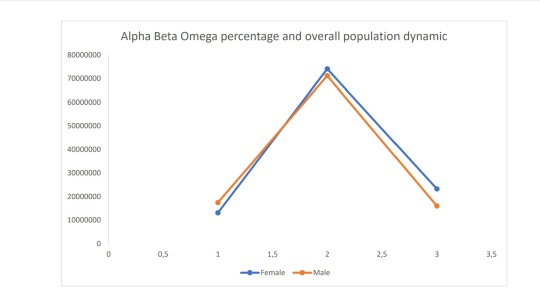
Second out of three parts coming right up, Tumblr won't let me post more images !
Also stay tuned, next part is gonna include a list of the Batfam members who I think are Omegas
#somone please shut my 🤓👆🏾 ass up#a/b/o dynamics#a/b/o au#alpha beta omega#batfam#batman comics#batman#jason todd#tim drake#clois#clark kent#stephanie brown#duke thomas#signal
46 notes
·
View notes
Text
Irken senses, and other ponderings
You know, every time I start to wonder if I’ve finally run out of things to coherently say on the whole “speculating about irken biology” matter, a whole something more is induced to hatch out of the dehydrated floam inside my skull. Between you and me, I think the eggs are triggered by ironic timing.
Anywho, I’ve been thinking a lot lately about the world hypothetically through Irken eyes, and other sensory organs. Think I’ll go down them piece by piece, and to follow the pattern I’ve kept through my other Irken brain dumps, I will be drawing a huge amount of inspiration from real life arthropods. Yes, I’m very aware that realistically, any resemblance to earth insects would be coincidental from an alien species, and there’s plenty of room to make up whatever somewhat plausible explanation you can for any faucet of their anatomy. Personally, I like to run from the convergent evolution angle, since I find it no less grounded, full of potential connections the show itself all but begs me to draw, and just plain fun. Let’s get into it.
Also like towards the end there’s a whole section on the hypothetical edibility of Irkens because why not

Prelude: If you want to hear a little more behind my theory about the Irken diet revolving around sugar and a small portion of minerals, you can zip onto this analysis I did, in which I touch on some ideas of mine regarding the composition of Irken skin, their reaction to meat, etc. that works from the assumption that Irkens evolved out of an arthropod-like ancestor. Not necessary to get the gist of this one, but it is background context behind my thought process.
Sight
The Irken oculus is perhaps the most striking feature of the species, very much resembling those tiny crawling things they have been inspired by; however, it’s tougher to say exactly how far the similarity of their insides go. The eyes of most arthropods are in fact along the more simple branches of the evolutionary tree. We know that Irkens are not likely to possess compound eyes, like those found in flies and most other insects, because compound eyes are specialized for wide FOV ranges at the sacrifice of visual resolution quality. Instead, I see a much closer match to a fascinating exception or two found in Earth’s arachnids.
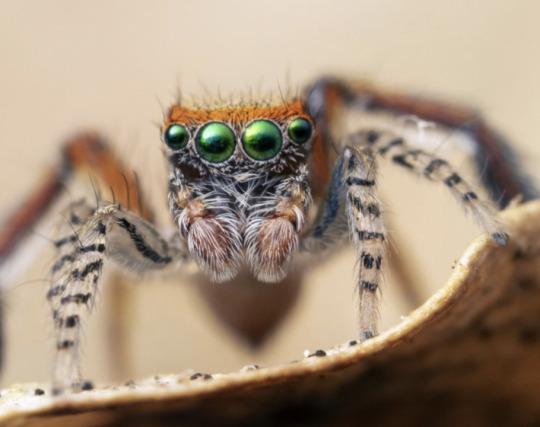
While most of them have utterly piss-poor vision, the hunting styles of jumping spiders necessitated a great deal of further specialization of the organs for depth perception, color differentiation, and sharp images. These are the purpose of those two huge shiners at the front (the other 6 boosting their range for detecting blurry peripheral movement and threats), and these are what bring their effective vision on a level much closer to that of familiar binocular mammals than their own six legged prey. Now I really think we are working with the base of what Irken peepers likely developed out of. One of the ways they have really diverged off is in the fact that while jumping spiders can only move their retinas, irkens seem as though they are able to move the lens of the eye themselves- or at the very least, Zim does, else the false pupils in his disguise contacts would not behave quite so convincingly. To speak about the lenses themselves, their eyes are not dry and exposed like most arthropods, speaking to a vulnerable sensitivity. They clearly have blinking eyelids, shed tears, and Zim even complains about the “scratchy” feeling of getting used to that part of his kid disguise.
(Funny sidenote: I’m like 90% sure that Zim did not have those contact lenses designed correctly for himself. Usually, if contacts feel that uncomfortable and keep falling off of the eye as easily as his do, it’s a sign of them being poorly fitted. This could be another symptom of his outdated/lower quality invader tech.)
Not only do Irkens have an assumed base vision resolution that seems more or less on par with human beings, but Invader elites are fitted with ocular implants that grant them a significantly greater advantage in this realm. We don’t know to a certainty how well improved an Irken soldier’s vision is, but Zim was confidently able, within seconds and under pressure, to pick out the area of town he lived in from what was miles away under night hours.
On the topic of night vision, I have a hunch that even without the cybernetics, these guys are adapted to see much better than we in dim to dark environments as well. Most of the early part of their life cycle is lived out in subterranean crèches. On the surface, daytime Irk is cast in a sunset red atmosphere. Oddly, a massive portion of their fashion and architectural aesthetics show a preference for these dark, warmer tones. Ruby is far and away the most common eye color in their kind. All of these facts suggest that warm-spectrum hues and pigments were incredibly common in the homeworld’s history, to point of indicating something about a cultural attraction to them- kind of like how humans put the color blue all over so much corporate branding and elsewhere. Zim’s favorite color has also been revealed to be purple. Most of all, given what I’ve seen of Irk’s, Blorch’s, and Devastis’s surface skies, AND Zim’s reaction to staring directly at the sun for more than a few seconds, I’m assuming that most Irkens are wholly unfamiliar with living in an environment as brightly lit as midday Earth.
I do think Irken eyes “glow” in the dark, but not in the emitting sense. Just more in the reflective one. This they would owe to a well developed tapetum lucidum, as seen in cats and deer and pretty much any animal to give off an eerie eye shine under the right lighting. To point back to arachnids, wolf spiders are speedy nocturnal murder machines with highly developed tapetum lucida, in their secondary eyes, at least. What I love the most about that is it makes it very easy to tell if you’re looking at a mother spider because her babies will give off the same eyeshine if you take a pic of one with the flash on.

Additionally, I won’t forget that sleep is no longer a necessity for our alien subjects. This alone gives them a major edge over any dinural race such as humanity. While Zim has his appearances to keep up during the day, the nighttime on Earth is actually when he is allowed the most free rein to work on his endeavors uninterrupted.
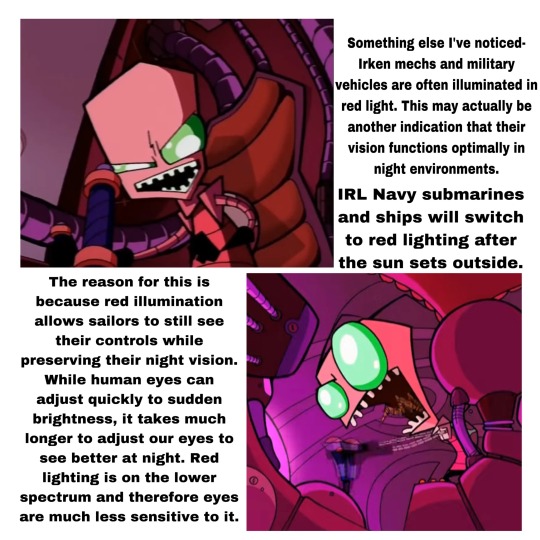
Sound
Ah, so this is the part where I rattle off the common theories we’ve collectively formed about Irken antennae as the replacement for an external ear, eh? Yes, but actually no…. jokes aside, it’s just no. I’ll get to the deal with antennae, but as you might imagine, hearing ability also varies all over the place in the insect world.
It is true that antennae play a large role in the hearing of some critters, such as mosquitoes, whose males use them to pick out the high frequency wing beats of nearby females in a swarm. Crickets, on the other hand, use sensory organs on their legs tuned to much lower sound ranges. There’s no one way to evolutionarily put together a sort-of ear, as well proven by the sheer amount of times it convergently happened in bugs and in how many creative ways.
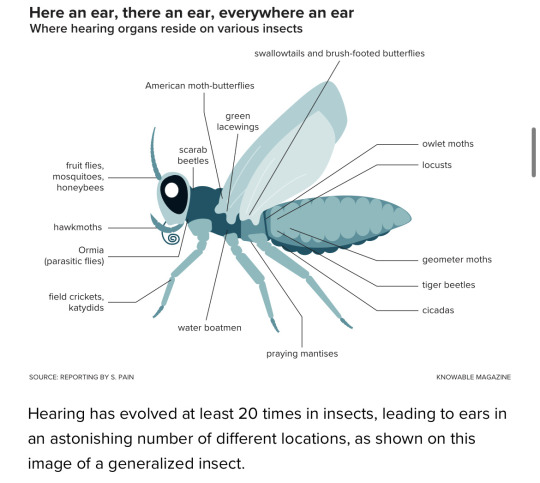
They literally be designing themselves like me playing around in spore. If we’re not talking about that mosquito or honeybee example, then what we are referring to as an ear and most hearing insects is going to be an external tympanic organ. Most people who have passed high school biology would be able to recognize a visible tympanum in frogs- that circular thing right behind the eyes in most species, and understand it as their version of an ear drum. Many bugs’ tympanums are likewise thin chitinous membranes situated… potentially just about anywhere on the body (again, see above). This is what I think Irkens use as a primary hearing organ, in his case, probably situated on their heads in addition to the feelers. The latter organs I think would also be sensitive to general vibrations and subtler environmental cues, like wind direction and pressure changes, but the bulk of their hearing would be owed to the tympanum.
As far as the quality of their hearing, well, there’s not any sign it differs much from the human experience. Like us, they communicate through verbal language, and the existence of the “Dancing Arcade Game (but for aliens)” confirms at least a similar cultural propensity for music as an entertainment form. Zim is an outlier for the fact that he seems genuinely a little hard of hearing next to his kin, screaming as naturally as he talks and repeatedly mishearing (if hearing at all) people who are speaking directly at him. It’s clear something’s up with his hearing, but there’s no clear answer what and why. At first I was tempted to suggest something about sound passing much differently through the medium of earth’s atmosphere (kind of like how noise on Mars would sound muffled to us), but neither Tak nor Skoodge seemed to pick up the problem when they arrived. It really could be as simple as some kind of birth defect, or even glitches in how his corrupted PAK is processing the inputs it receives. Like many others, I want to imagine that his wig could be interfering too, since it covers the whole top portion of his head; as well, I noticed he has more of those incidents with it on than not.
Smell
Alrighty, NOW we can round back to focusing on the antennae, because this is actually the main thing our insects fine tuned theirs for. And when I say fine tuned- I mean fine tuned. Blood suckers that find their prey through the CO2 of their breath, flies that can pick up on potential food sources from miles away; In the land of the little, scent is everything. Beyond it being their main tool for exploring the environment for what to eat and what to avoid, chemical messages are the backbone of bug-to-bug communication. Pheromones are the divining rod of lonely spiders looking for a mate. They are the bugle of yellow jackets when rallying the nest to attack a threat, and they are the signals that govern about every single action an ant takes from adulthood until death. Obviously, Irkens are much more sight & hearing dependent than these comparisons, but they still have much more bodily specialization dedicated to this sense than we can relate to. For one, they are fastidiously hygienic. Like, “the care-bots from that really creepy episode of the Buzz lightyear cartoon” hygienic. We have yet to see any livable surface of Irk that is not sky to underground terraformed over in all-consuming metal infrastructure. There’s less than no sign of visible life besides the Irkens; ffs, there’s not even soil in sight. Not on Devastis, either. The Organic Sweep sounds like such a nice and pretty euphemism in the face of the actual horror of Blorch’s fate, and all to spare the boots of their military from touching even a speck of “unsavory alien filth”. They live in such a controlled and purified environment that I can’t even imagine the absolute assault on the senses Zim’s every day on our barbaric ball of dirt is. Over and over again he gives off the impression that the constant stink of this place is in fact his chief complaint about living among us. The majority of insults he throws toward humans relate to how they smell or the fact that he finds them “filthy”. We’re flat out nasty to him and I don’t blame him. Even relative to other animals, humans are especially RANK due to the combination of sweat, oils, and bacteria that coat our skin.
And believe it or not, I do think Irkens are in a position to talk shit in this regard. Zim is a really sweaty boi; however, I posed an idea back in that write up about Irken skin before- to summarize- that his kind maintain remarkably sterile cuticles due to the presence of a toxic chemical in their skin. This, I said then, could have been the key to Zim’s lice repelling trait, but I wasn’t so specific at the time about more than that. I got the idea from a group of millipedes that, when disturbed, can secrete hydrogen cyanide as a deterrent to predators. I like to imagine that Irkens can do a similar thing via sweating, not to thermoregulate like us, but as a stress response. It would at least explain why Zim seems like a very nervous sweater. Fun fact if you didn’t know, cyanide’s smell is similar to almonds.
I’m deadass telling you I think Irkens just smell like almond extract. Do with that what you will.
Touch
So, in writing this whole whatever it be, this part was the trickiest to come up with any productive analysis on. I’ve already guessed at what I think Irken skin feels most like (spoiler: hairless caterpillars) in the analysis I referenced up top. Zim being able to pass himself off as a human under the examination of the Skool nurse points to an average body temperature somewhere around our own. What I did find interesting while rewatching the series though was the sheer amount of pain tolerance on these invaders, except in one way. Can I extrapolate this fortitude to Irkens universally? Probably not! Zim is a member of the most elite of the most highly trained members of Irk’s military. I wouldn’t take what a seasoned veteran can handle and assume that’s the human floor in a nutshell, but our invaders CAN tell us quite a bit about their ceiling… starting with the fact that these bastards are ridiculously heat resistant. Irkens are a durable race broadly, but their reactions to extreme temperatures strike me as jaw-droppingly underwhelming, if anything.
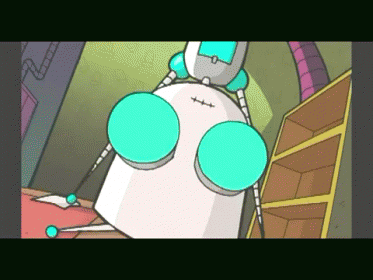
Irkens DON’T like being engulfed in flames. It’s still a painful experience to them, but seemingly the kind they can pretty much walk off as soon as it’s over. Through explosions and fire we have seen Zim (and Skoodge) survive in one piece. We’ve seen The Massive take a whole dip into a burning star with no ill effects to the crew within. Most amazing to me was the time in Battle of the Planets when Zim willingly piloted Mars into grazing by the Sun at close range while trying to evade Dib. Totally exposed driver’s seat and he was no worse for wear after this.

Further in the comics we see this touched on in the Zimvoid arc. Zib’s favorite method of torturing the Zims under his training program was to torch them at random for sadistic amusement. Quite interestingly, though, Number 2 implies that their bodies do actually adapt to this treatment over time! Theoretically, Zims further along in the program have become all but invulnerable to fire entirely.

On the other hand, one of the truly most painful things Zim has been shown to experience is to have his skin chemically burned. It’s a strange sort of irony that Earth’s water would prove to be an incapacitating force to them in place of any inferno. He’ll smash his skull into the Voot’s windshield with enough force to pop out an eyeball and it’s whatever. Plenty of other things hurt, but he can power through. You turn a shaken can of soda or a bottle of bbq sauce on him and he’s just left screaming on the ground or screaming and running away. Whatever brutal sort of training he had to go through off world, it didn’t prepare him for this.
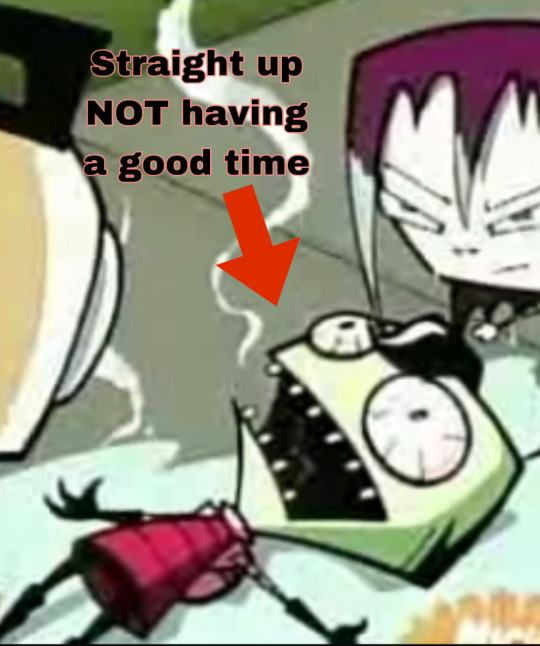
Taste
The perceptive side of this I think may not be too hard to figure out. Irken food, as alien as its actual composition could be, has been shown to be heavily analogous to human junk food. I hesitate to call what Irkens are scarfing down “meals” in the proper sense, because I’ve noticed that neither Zim nor his kin intrinsically understand the concept. When he’s trying to blend in as a human being, he puts a LOT of bizarre effort into convincing us that he, just like you inferior creatures, TOTALLY eats “food” on a regular basis like a normal person. When Irkens eat their own products, it’s all and only “snacks”. What follows is the conclusion that their eating habits are not structured into any schedule and that Irkens instead graze throughout the day as they please- and even possibly that eating altogether is more a recreation to them, instead of a necessary function to sustain life. Some fans have speculated that the PAK could provide an Irken with all of the necessary energy to survive absent of nutrition. I kind of want to contest this, given that caloric energy is only one purpose of taking in food… but it’s definitely the most immediate one. Nonetheless, they still eat constantly on screen and it all has to be going somewhere. Whether they need it or not, they still readily digest snacks (and presumably use those chemical building blocks to regenerate tissue damage) with a terrifying metabolic efficiency. Assuming that the resemblance of their snack foods and our leisure treats are not purely coincidental, one gathers that sweetness is the largest dimension of Irken cuisine. They are drawn most enthusiastically to carb-dense synthetic, plant, and possibly fungal matter in the same way that the human brain lights up at the prospect of fat and sugar-loaded meals. The flexible tongues of Irkens to me also resemble the nectar catching, segmented mouthparts of some bees. I would be willing to bet that they can taste salt, but jury’s out if it is something they crave, like us, or are repulsed by, like ants. That would have to come down to the scarcity (or not) of the resource on their home planet and whether or not desiccation was a serious threat in their natural history. In other regards, Zim shows strong negative reactions to most Earth foods, if not physically, than in his expressions. They definitely have powerful vulnerabilities to many human ingredients, and so are very sensitive to the presence of these toxins. I can’t imagine acidic or bitter substances are at all pleasant to them.
Now comes the much more interesting question I’ve thought way too long and hard about in the shower a time or two. Knowing that Irkens are likely a herbivorous breed, ergo, thankfully would have no interest in the consumption of the human race… what about the vise versa??? I don’t just want to know what they taste, but what would they taste like?

So, you’ve decided to mix it up for the thanksgiving dinner and forgo the same boring old bird for an Irken you have vanquished (via what I can only imagine was a freaking miracle of luck). What should you come to expect? Most importantly and I must emphasize this, the secret to preparing their meat is the same as Tolkien dwarves, you have to skin them before anything else. The separation of edible tissues from the cuticle is necessary to avoid ingesting the defensive toxins it contains. Even if the concentration is not enough to provide a danger to you, it could end up contributing an unpleasant, bitter flavor to the final product.
That done, discard the head and digestive organs. True as it may be that Irkens are wholly free of parasites, with a chance that the viscera could be edible, it’s not likely to taste that great and besides, do you really want to take chances with exposing yourself to an entirely foreign gut biome you have no immune adaptations to? And don’t even think about the brain- I don’t care how rare the infection rates are, alien prions are a big no. If you happen to run into any cybernetic implants during the cleaning, however, set them aside! They could be worth a small fortune in the right circles. But, for the purpose of eating we’re really concerned with the muscle tissues, a delicate white meat with a texture similar to fresh crab. The bones need not be wasted, and are fine to leave in, or can be boiled on their own to make a flavorful stock which can be added to soups or a delightful gravy. A surprisingly practical use of Irken bone could also be in the compost bin, being rich in chitosan and other powerful garden fertilizers. The flesh can do well fried, or roasted to a crispy exterior. The oven rule is the same as chicken, low and slow, to prevent drying out. Don’t be afraid to experiment with the gravy idea or marinades. The flavor profile of the meat itself would be utterly unique from what most of us are used to, comparable to a nutty crayfish. Savory, a bit of a sweetness, and a mineral hint that pairs quite well with mushrooms or rice.
I can’t recommend serving this to any guests with shellfish allergies in good conscience. If they insist, do so in caution and with knowledge of the risk of cross reactivity.
And there you have …. certainly a thing I did write and queue up for y’all!
#invader Zim#iz#irkens#iz analysis#iz headcanons#cool bug facts#insects#speculative biology#hear me out#it’s not cannibalism if it’s interspecies#I apologize for writing this while hungry#scarlet talks about things#scarlet really should have eaten breakfast today#also happy thanksgiving????#cw arachnid#long post
98 notes
·
View notes
Text
Short Head of Biceps Femoris

Patreon
#studyblr#notes#medblr#medical notes#med notes#anatomy#human anatomy#evolutionary anatomy#human evolutionary anatomy#evolution#evolutionary biology#biology#bio#anatomy notes#human evolution#evolutionary bio#evo bio#evodevo#evolutionary development#developmental biology#devbio#anthropology#anthropology notes#bioanthropology#biological anthropology#anatomy and physiology#anatomy & physiology#medical science#life science#health science
2 notes
·
View notes
Text
World Tomistoma Day 2023
Although I find the concept of a "World Day of" generally stupid, I believe that on the matter of endangered species, it can be a very meaningful speaker.
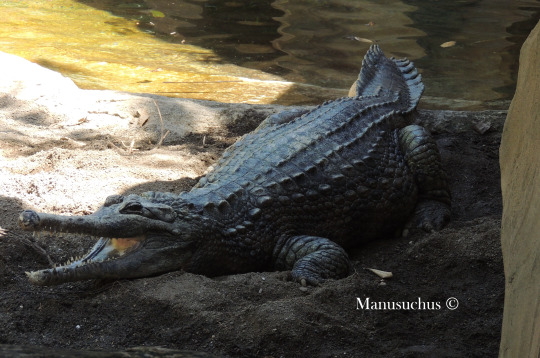
Tomsen, a female T. schlegelii at BioParc Fuengirola (Spain)
Today, August 5th, an initiative of the Crocodile Specialist Group (CSG) together with the "Tomistoma Task Force" is trying to draw attention to this poorly known and misunderstood species.
For those of you who don't know this animal, Tomistoma schlegelii, commonly known as Malayan false gharial is a longirostrine crocodilian that inhabits forested freshwater lakes, slow-moving rivers and swamps of Peninsular Malaysia, Borneo, Sumatra and possibly Java, feeding on diverse prey (From invertebrates to monkeys, small deer, birds and reptiles, with fish constituting the bulk of its diet), and although it is not a particularly aggressive species, there are several records of attacks on humans, with at least one fatal confirmed.
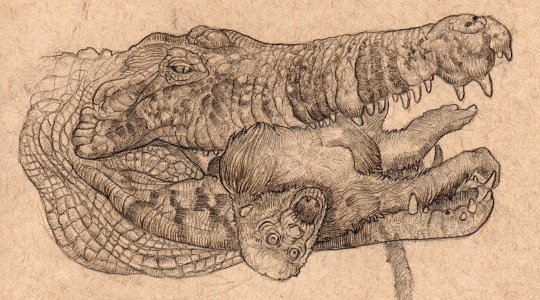
Tomistoma schlegelii devouring a female proboscis monkey (Nasalis larvatus). Inspired by Galdikas et al. 1985 (Illustration made in 2022)
It is characterized by a long narrow snout which blends gradually with the base of the head/skull. Two rows of very small, barely distinct post-occipital scutes. Nuchal scales continuous with dorsal scutes and are almost indistinguishable. They are generally brown in color, with dark bands, including blotches and bands on snout and jaws.
But what makes this species really interesting are two particularities : Its enormous size and its ínteresting taxonomic affinities:
a) Size: It is not uncommon for Tomistoma males to reach lengths of 4 m today, but skeletal remains (Mainly skulls) indicate that we could be (Although improbably) in the presence of one of the candidates for the largest crocodylian species in the world .
In their 2008 study, R. & N. Whitaker noted that the longest skulls in the world belonged to Tomistoma (One at Munich Museum at 81.5 cm; another at the AMNH at 76.5 cm ...) with the British Museum specimen taking the lead with an incredible 84 cm (Leaving all other species behind).
However, observations made on Tomistomas in captivity at the Samut Prakarn Crocodile Farm (Bangkok) and on some wild specimens, determined that the HL:TL ratio was 1:6.4 for the species; and therefore, the British Museum specimen would have measured about 5.38 m in life, certainly a giant but far from the monstrous sizes of some salties (Crocodylus porosus).

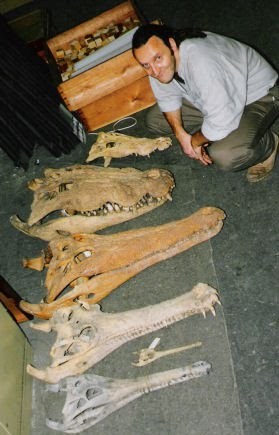
The British Museum specimen. George Craig © (In the second photo, you can compare the size with C. porosus and G. gangeticus large specimens)
b) Uncertain affinities: Tomistoma is the last survivor of an old lineage that originated about 40-50 mya ago. This has made many authors wonder: where does this species fit in the evolutionary tree of crocodylia? And well... it's complicated.
T. schlegelii has long been considered to be a member of the Crocodylidae ( Brochu 2003). Much of the analysis has focussed on skeletal attributes, often constrained that way to allow comparison with fossil material, but there is supporting evidence from soft anatomy as well (Frey et al. (1989) , Endo et al.(2002)...)
But now begins the tricky part : Molecular analyses place Tomistoma as a Gavialid.
( White and Densmore 2001; Janke et al. 2005;McAliley et al. 2006, Roos et al. 2007; Man et al. 2011...) Although some of these studies have been criticized for their methodology, it is clear that it cannot be ignored that they all reach the same conclusion.
Likewise, there are important discrepancies about the times and periods in which both families appear/diverge, so the debate is not yet definitely closed.
Tomistoma are considered vulnerable by the IUCN Red List, nonetheless, it remains possible that T. schlegelii may qualify as Endangered in the future due to ongoing habitat loss and degradation, particularly Malaysia, so this day is still important to spread the word about the species.
I have only been able to enjoy these animals live once, at the BioParc in Fuengirola, Málaga (Spain) where they keep a trio of three adult specimens: Two females (Montse and Tomsen) and a huge male (René, affectionately nicknamed "Pinocho"). This Zoo is the only one in Spain that houses Tomistomas and has achieved the titanic task of their reproduction in captivity.
René, the huge male at BioParc Fuengirola. Video by me.
#zoology#animals#reptiles#crocodiles#nature#crocodilians#wildlife#science#conservation#endangered species#endangered animals
114 notes
·
View notes
Text
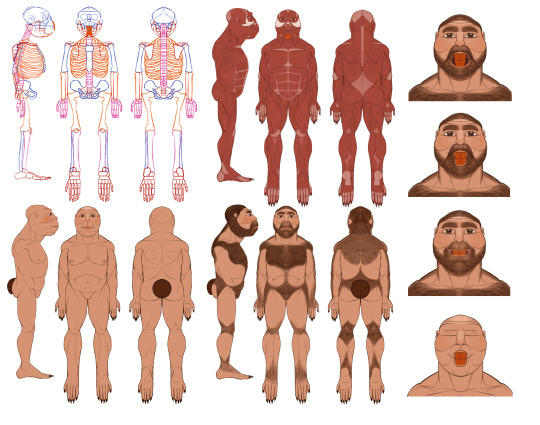
An introduction to Castor erectus:
Castor erectus, common name "Mountain Dwarf" is member of Castorimorphia, a suborder of rodents that consists of the superfamilies Castoroidea, (Modern Beavers) and Geomyoidea (Kangaroo Rats).
In our current timeline, the genus Castor has only two extant members, Castor canadensis, common name "North American Beaver", and Castor fiber, common name "Eurasian Beaver".
Castor erectus offers an alternate evolutionary history where Beavers evolved to fill human-like niches. Their look and culture are heavily inspired by the stories of Dwarves as told in fantasy epics such as Lord of the Rings, as well as stories of dwarves from Germanic folklore. Their design is meant to be unique enough to offer an interesting history and flavor for Dwarves, while still being familiar enough to be recognizable as Dwarves.
Castor erectus stands at an average of 4'5", with specimens varying in height by +/- 4 inches (for healthy adults.) Female dwarves are on average 3 inches shorter than their male counterparts.
Castor erectus shows little to no sexual dimorphism. (You may have seen my previous sexual dimorphism model, this was based on my incorrect assumption that strong sexual dimorphism was present across most mammals.) Modern beavers lack external genitalia, a trait that is present in Castor erectus, which makes it difficult to distinguish a Dwarf's sex. Members of the species can easily distinguish the sex of other members through smell, though their culture does not place a heavy emphasis on gender. The Dwarven language lacks gendered pronouns, and sexuality among Dwarves is incredibly fluid. Same sex pairings can be a helpful evolutionary tool, allowing communal-living social species to meet the social and sexual needs of its' members, without increasing population of their colony to an unsustainable size.
Dwarves typically live in large colonies constructed in and around mountain cave systems. These structures are known as Lodges, which are an evolved form of modern beaver habitats. The construction of these lodges generally begins with the construction of a large cistern, and a canal below the snowcap of their home mountain which diverts runoff into the cistern for collection. They use this collected water to fuel primitive aquaponics and hydroponics systems in their lodges. Dwarves are often separated into small familial groups, but it is not uncommon for distantly related groups to merge into a single colony to control resources and water.
In the future, I will be posting more illustrations and writings detailing Dwarven Culture, as well as exploring their evolutionary history through extinct relatives. If you have any questions about their culture or anatomy in the mean time, feel free to ask! Any amount of feedback helps to flesh them out and answer questions I might not have otherwise thought of.
#dwarves#dwarf#speculative anatomy#speculative zoology#speculative biology#spec bio#specbio#fantasy art#evolution#anatomy#digital art
37 notes
·
View notes
Note
tried to explain to my male friend (ugh) that gender ideology is flawed and gender roles are not what makes a woman and he WOULD NOT get it. I was like, a woman is biologically female. He was like well that's not what a woman is. I was like 😐 youre not getting it, i don't have the energy for this right now. He's also "nonbinary". He's one of my oldest friends and i'm not sure it's worth it anymore
im sorry to hear that, anon :/ it always sucks when you're talking to someone, especially a friend, and they don't understand what you're saying at all
I do think we should start making it very explicitly clear that "woman" and such are not gender terms, because I've so often seen "female is the sex, woman is the gender." I think that people often don't realize we aren't operating under that idea at all. when we say woman, we only mean sex. we do NOT mean gender at all. I think that's likely where a lot of the "radfems are essentialist" myth comes from.
Check out some of my posts comparing sex to hair or eye color & how weird everyone would find it if we imposed gender based on those neutral physical traits rather than sex. imagine a world where brunettes are expected and stereotyped and pressured to be soft, emotional caregivers who wear flowy dresses and flowers in their hair, and blondes are expected to dress comfortably and be commandeering and stoic; the radfem take is that we should get rid of that absurd system and everyone should be able to act and dress and do whatever they want without silly expectations based on arbitrary physical traits. This is how radfems view gender. Sex is a neutral, immutable biological trait. Like hair or eye color, you may be able to disguise your sex or alter how others may perceive you, but your hair color/eye color/sex remains unchanged.
As for terms like man and woman, and the definition of sex:
Sex is based on gametes, not chromosomes or genitalia or sexondary sex characteristics. The female sex - in humans and other animals - is the sex whose bodies/anatomy/physiology/genetics/chemical and hormonal makeup are designed and structured entirely around the ability to produce large gametes (ova). Whether or not a female of a given species is lacking certain parts (such as a uterus), is born with a DSD, or is infertile, their body has still entirely developed from before birth with the evolutionary, biological intention or producing large gametes. It is utterly irrelevant whether those gametes are produced successfully or not, or whether they are fertilized or not.
As for man and woman, what we mean when we say "a woman is an adult human female, a male is an adult human male" is no different than what one means by "a doe is a female deer, a buck is a male deer." These terms denote species and sex, as well as youth vs adult status in many animals. This includes humans (woman/girl, man/boy) along with goats (doe/doeling, buck/buckling) and plenty others.
A woman is a female (adult) human being, just as a brunette is a human being with brown hair. Saying that she is a woman because she is female does not reduce her to her vagina* any more than saying a brunette has brown hair "reduces" that person to brown hair. We all know that brown hair is just a visible physical characteristic we are describing to quickly categorize a person, and we all know that person is much, much more than just walking, talking brown hair. So why have so many who subscribe to gender ideology allowed themselves to be convinced that the definition of woman is "reducing" women to vaginas or other female anatomy? This is especially odd when you remember that this is the same group of people who thinks the best way to describe human members of the female sex is "vagina havers," "uterus owners," "menstruators," etc.
*And again, the definition of female is not "has a vagina," anyway, as I discussed above.
There is nothing restrictive about this definition. It applies to FIFTY PERCENT of human beings. It includes women who can't have children, women who don't want children, homosexual women, women who would sooner die than shave a single armpit hair, bodybuilder women, intersex women, women who have taken cross-sex hormones and undergone mastectomies and phalloplasties, women who love trucks and mudding, prostituted women, women who hate pineapples on pizza, women who love pineapples on pizza... women of every single size and color and personality and lifestyle under the sun fit perfectly into this short, simple, and clear non-circular(!) definition.
"A woman is anyone who identifies as a woman" can simply never make any sense. Think about it in mathematical terms. If X = Y, right, then they are the same and any Y can be replaced with X and vice versa. So let's define our terms here.
X being the word "woman"
Y being the definition of the word "woman"
Then X = Y should reasonably be assumed to be true.
However, if the definition of woman is "anyone who identifies as a woman," then we have X = Y, where Y = anyone who identifies as X. This looks like X = anyone who identifies as anyone who identifies as anyone who identifies as... ad infinitum. This quite simply leaves X with absolutely zero meaning whatsoever.
I hope this information can help your friend or perhaps someone else understand what we mean when we say this, and why it doesn't have anything to do with hatred or wanting someone/some group to not have rights or even to die.
80 notes
·
View notes
Text
What’s more foreign to man than the surface of the moon?
Apparently, it’s human female genital anatomy. The clitoris is 10 times larger than you think. The full structure of the clitoris was only fully mapped in 2005, and the first 3D images of the clitoris during stimulation were created in 2009. Both of these events occurred after we mapped the entire human genome. But perhaps a better comparison would be the study of male genitalia: male genital anatomy has been actively studied for hundreds of years, and studied through MRI since the 1970s.
The study of the clitoris, on the other hand, has been plagued with sexism since its inception. Scientists who claimed to have “discovered” the clitoris in the 1500s (apparently unable to understand that women had been discovering their bodies for centuries) proposed that it either had no function or was not present in healthy women. Alternatively, it was believed that the existence of a clitoris on a woman proved she was a witch. (Thanks I guess?) Gray's Anatomy included the clitoris in 1901, yet it was absent from the 1948 edition, and its study was grossly neglected throughout the majority of the 20th century. The idea that the clitoris has no real function persists to this day, and so does ignorance about its full structure. There are many reasons for the scientific neglect of the clitoris including the shame that we attach to female sexuality, and the lack of consideration given to women’s health in a patriarchal system. It is imperative that we understand all aspects of the human body. Not understanding the full structure of the clitoris has devastating consequences during pelvic surgery.
So, what is the full structure? In 2005, Australian urologist Helen O’Connell, through dissection and MRI, “showed that the erectile vestibular bulbs are a part of the clitoris, and that the female urethra and vagina, although not erectile in character, are closely related structures that form a tissue cluster with the clitoris that is the site of female sexual function and orgasm.” This and later studies showed that the erectile tissue of the clitoris surrounds the vagina, and that the sensitivity of the vaginal anterior wall is due to the full structure of the clitoris. Yet, despite these huge leaps in scientific knowledge, the full structure of the clitoris is not taught in most sex ed. I had seen detailed anatomical diagrams of the penis for decades before I ever even heard that there was more to the clitoris than meets the eye. Why?
Men and boys continue to ask if the “g-spot” is real and if so “where is it” as if they are wondering about the existence of extraterrestrial life. But this isn’t some great unknown that we have to wait lifetimes to understand. Women have known for centuries that stimulation of the clitoris makes penetration more pleasurable, and our anatomical understanding of the clitoris shows why. Women’s body’s are not the unknowns of science fiction. Moreover, the understanding of women’s anatomy and sexual health is a human right.

Image source: https://www.theatlantic.com/health/archive/2017/03/3d-clitoris/518991/
Fun fact: every female mammal has a clitoris, and so do some non-mammalian species. In early mammals, stimulation of the clitoris, which was inside the vaginal canal, triggered ovulation. This leads us toward an evolutionary understanding of the female orgasm.
808 notes
·
View notes
Text
Submitted via Google Form:
Hi, I want my aliens to look human but inside the body they have different/unique body parts/configurations. Like they have two stomachs or a herbivore stomach, several hearts. What if the stomach was above the heart? Or some completely new organ/glands like idk one that can do photosynthesis or that does different jobs like idk the liver/pancreas is a combined one organ or some mix inbetween. I'm not sure where I can make things up in a way that makes sense other than just dropping them in just for fun.
Tex: Stomachs are usually below hearts because of gravity reasons, I believe, but there’s plenty of opportunity to have organs in different positions or different types of organs in a humanoid body according to different ecological needs. What does the environment of the species you’re building for look like? What would they need in terms of adaptations for food, solar radiation, and climate?
Utuabzu: If you're going to go deep into the internal biology of your aliens, you might want to consider their evolutionary history. Anatomy isn't always very efficient, because it doesn't necessarily need to be. A feature just needs to not be seriously detrimental to persist. For instance, our eyes have a blind spot because the blood vessels are actually in front of the cornea, which means that there's a hole in the cornea that the blood vessels enter through. This is a feature shared by all vertebrates (animals with spines), and thus must have been a feature of our most recent common ancestor. Our brains just fill in that gap with guesswork and information from the other eye, and move on. The recurrent laryngeal nerve, which controls the muscles of the larynx (which are required for speech), actually loops under the aorta, and is thus far longer than it needs to be, because deep in our evolutionary past that route was more direct, and this overly long route is not detrimental to our survival and reproduction, so it is not selected against.
Basically, even the weirdest anatomical features exist for a reason, usually either that they are serving a function, used to serve a function but no longer do and their presence doesn't impede survival or reproduction, or are the result of a random mutation and are not impeding survival or reproduction. In many cases, even the seemingly useless features do actually do something, for instance the human appendix acts as a reservoir for gut microbiota that can then repopulate the intestines after an… event that removed much of it. So, my advice is that if you're going to go into detail about the species internal anatomy, ask yourself why any given odd feature exists and if it aids or impedes survival and reproduction, because that's what dictates which features persist and which do not.
Miri: There’s a doctor on youtube who has a done a series of videos on the Games Workshop Space Marines and their anatomical alterations: https://youtu.be/7OXjNpNpWXw?si=zzlhO2FpQbaUuD5v
20 notes
·
View notes
Text
THE TREE OF NATURAL SCIENCE

LIFE SCIENCE -> Any science concerned with the study of living organisms
THE BRANCHES OF LIFE SCIENCE:
BIOLOGY
This branch of life science will study living organisms, and it will be divided into many specialized branches that cover their morphology, physiology, anatomy, behavior, origin, and distribution.
THE BRANCHES OF BIOLOGY:
CONSERVATION
This branch of biology will study environmental conservation and biodiversity on Earth.
■Wildlife Management is a branch of conservation that will specialize in the concern for the management process influencing the interaction between wildlife, its habitat, and people in order to achieve the pre-defined impact.
ECOLOGY
This branch of biology will study how organisms interact with the environment around them.
■Autecology is a branch of ecology that will specialize in studying a specific organism of a species.
■Synecology is a branch of ecology that will specialize in studying an ecosystem.
EVOLUTION
This branch of biology will study any evolutionary process with its regard to diversification and adaptation over many years.
GENETICS
This branch of biology will study genes, genetic variation, and heredity.
MARINE BIOLOGY
This branch of biology will study marine organisms.
■Ichthyology is a branch of marine biology that will specialize in studying fish.
MEDICINE
This branch of biology will study managing the diagnosis, prognosis, prevention, treatment, palliation of an injury or disease, and promoting the health of a patient through such mentioned practice.
■Psychiatry is a branch of medicine that will devote itself to the diagnosis, prevention, and treatment of deleterious mental conditions.
□Addiction psychiatry is a branch of psychiatry that will focus on the evaluation, diagnosis, and treatment of people who have one or more disorders related to addiction.
□Forsenic psychiatry is a branch of psychiatry that will be applied in a legal context involving any civil, criminal, correctional, regulatory, or legislative issues.
□Neuropsychiatry is a branch of psychiatry that will examine both organic and psychological aspects as a cause for illness.
□Occupational psychiatry is a branch of psychiatry that will use the extension of psychiatric knowledge and skill to the day-to-day functioning of individuals in the workplace and their organizations, with the goal of helping both function better.
□Geriatric psychiatry is a branch of psychiatry that will center itself on prevention, evaluation, diagnosis, and treatment of mental and emotional disorders in the elderly.
□Child psychiatry is a branch of psychiatry that will be concerned with the study and treatment of mental, emotional, and behavioral disorders of childhood.
□Adolescent psychiatry is a branch of psychiatry that will be interested in the diagnosis and the treatment of disorders of thinking, feeling, and/or behavior affecting children, adolescents, and their families.
MOLECULAR BIOLOGY
This branch of biology will study the chemical structure and any biological process of a molecule.
PHYSIOLOGY
This branch of biology will study how the human body functions.
BOTANY
This branch of biology will study plants.
■Mycology is a branch of botany that will focus on the study of fungi, including their taxonomy, genetics, physiology, and any ecological role.
ZOOLOGY
This branch of biology will study the entire animal kingdom.
■Anthrozoology is a branch of zoology that will study the interaction between any human and another animal.
■Arachnology is a branch of zoology that will handle the study of spiders and any related species known as arachnids.
■Cetology is a branch of zoology that will be interested in the study of marine mammals.
■Entomology is a branch of zoology that will focus on the study of insects.
1. COLEOPTEROLOGY is the sub-branch of entomology that will concern itself with the study of the beetle.
2. DIPTEROLOGY is the sub-branch of entomology that will study all types of flies.
3. ISOPTEROLOGY is the sub-branch of entomology concerned with the study of the termite.
MICROBIOLOGY
This branch of biology will study any microorganism.
CHEMISTRY ->
The study of the identification of the substances that which matter is comprised; the investigation of their properties and the methods in which they interact, combine, and change; and the use of these processes to form new substances.
THE BRANCHES OF CHEMISTRY:
ORGANIC CHEMISTRY
The branch of chemistry that's concerned with the study of an organic substance and compound.
INORGANIC CHEMISTRY
The branch of chemistry that will examine the properties and behavior of inorganic compounds, which would include any metal, mineral, and organometallic compound.
PHYSICAL CHEMISTRY
The branch of chemistry concentrated on the application of technique and theory of physics to the study of the chemical system.
ANALYTICAL CHEMISTRY
The branch of chemistry interested in obtaining, processing, and communicating information about the composition and structure of matter.
STEREOCHEMISTRY
The branch of chemistry illustrating the three-dimensional arrangement of atoms and molecules and its effect on the chemical reaction.
BIOCHEMISTRY
The branch of chemistry that will evaluate the chemical and physicochemical processes and substances that occur within the living organism.
GEOCHEMISTRY
The branch of chemistry that will study the chemical composition of the earth and its rocks and minerals.
FORENSIC CHEMISTRY
The branch of chemistry that will use the application of chemistry to help law enforcement catch their criminal.
PHYSICS ->
The study of the structure of matter and how the fundamental constituents of the universe interact.
THE BRANCHES OF PHYSICS:
OPTICS
The branch of physics that will study the sense of sight and the behavior of light, or the properties of transmission and deflection of other forms of radiation.
ELECTROMAGNETISM
The branch of physics that will investigate the interaction of electric currents or fields and magnetic fields.
RELATIVITY
The branch of physics that will examine special relativity and general relativity. For example, special relativity will apply to all physical phenomena in the absence of gravity, but general relativity will explain the law of gravitation and its relation to any force of nature.
THERMODYNAMICS
The branch of physics that will illustrate the energy and work of a system.
ACOUSTICS
The branch of physics that will vocalize the study of sound for us to hear it.
QUANTUM PHYSICS
The branch of physics that will focus on the study of matter and energy at the most fundamental level.
MECHANICS
The branch of physics that will examine the relationship between force, matter, and motion among a physical object. To define this, this force, when applied to an object, will result in the displacement or change of an object's position relative to its environment.
EARTH SCIENCE ->
See previous post regarding this topic.
37 notes
·
View notes